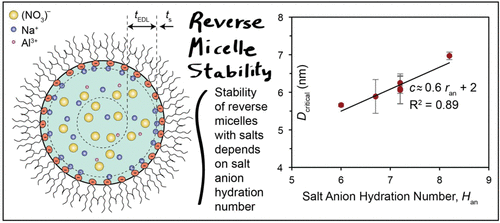当前位置:
X-MOL 学术
›
ACS Earth Space Chem.
›
论文详情
Our official English website, www.x-mol.net, welcomes your feedback! (Note: you will need to create a separate account there.)
Predicting Destabilization in Salt-Containing Aqueous Reverse Micellar Colloidal Systems
ACS Earth and Space Chemistry ( IF 3.4 ) Pub Date : 2021-08-13 , DOI: 10.1021/acsearthspacechem.1c00148 Robyn E. Ridley 1 , Hoorshad Fathi-Kelly 2 , James P. Kelly 1 , Victor R. Vasquez 3 , Olivia A. Graeve 1
ACS Earth and Space Chemistry ( IF 3.4 ) Pub Date : 2021-08-13 , DOI: 10.1021/acsearthspacechem.1c00148 Robyn E. Ridley 1 , Hoorshad Fathi-Kelly 2 , James P. Kelly 1 , Victor R. Vasquez 3 , Olivia A. Graeve 1
Affiliation

|
Colloidal systems, including micellar and reverse micellar mixtures, are essential for a variety of natural transport processes, such as the flow of organic and inorganic contaminants in lakes, rivers, and underground fissures. Thus, an understanding of their structure and stability is important for prediction of their behavior in complex environments. Previous experiments have shown that the solvodynamic diameters (D) of reverse micelles contract linearly with increased concentrations of salts such as NaBH4, FeSO4, Mg(NO3)2, CuCl2, Al(NO3)3, Fe(NO3)3, and Y(NO3)3. It has also been previously determined that reverse micelle size is a function of cation valency, through the Debye screening length (κ–1), and of anion hydrated radius. Here, we present a new theoretical model for the aqueous reverse micelle core substructure in water/AOT/isooctane colloidal systems with added salts. Our model is based on electrical double layer (EDL) theory and assumes ions are evenly distributed within the reverse micelle water core. We further analyze reverse micelle size with respect to ion hydration, reverse micelle water dynamics, and ion distribution, to propose a mechanism for reverse micelle contraction and determine the cause of system instability at the critical destabilization concentration for each salt. We find that destabilization occurs when the interfacial core water and waters needed for complete ion hydration exceed the water contained within the reverse micelle at its stable size. This establishes ion hydration capacity a likely primary mechanism for reverse micelle destabilization.
中文翻译:

预测含盐水性反胶束胶体系统的不稳定
胶体系统,包括胶束和反胶束混合物,对于各种自然运输过程至关重要,例如湖泊、河流和地下裂缝中有机和无机污染物的流动。因此,了解它们的结构和稳定性对于预测它们在复杂环境中的行为很重要。先前的实验表明,反胶束的溶剂动力学直径 ( D ) 随着盐浓度的增加而线性收缩,例如 NaBH 4、FeSO 4、Mg(NO 3 ) 2、CuCl 2、Al(NO 3 ) 3、Fe(NO 3 ) ) 3 , 和 Y(NO 3) 3 . 先前还确定,通过德拜筛选长度 (κ –1),以及阴离子水合半径。在这里,我们提出了一种新的理论模型,用于添加盐的水/AOT/异辛烷胶体体系中的水性反胶束核子结构。我们的模型基于双电层 (EDL) 理论,并假设离子均匀分布在反胶束水核内。我们进一步分析了与离子水合、反胶束水动力学和离子分布有关的反胶束大小,以提出一种反胶束收缩机制,并确定每种盐在临界失稳浓度下系统不稳定的原因。我们发现,当界面核心水和完全离子水合所需的水超过反胶束中稳定大小的水时,就会发生不稳定。
更新日期:2021-09-16
中文翻译:

预测含盐水性反胶束胶体系统的不稳定
胶体系统,包括胶束和反胶束混合物,对于各种自然运输过程至关重要,例如湖泊、河流和地下裂缝中有机和无机污染物的流动。因此,了解它们的结构和稳定性对于预测它们在复杂环境中的行为很重要。先前的实验表明,反胶束的溶剂动力学直径 ( D ) 随着盐浓度的增加而线性收缩,例如 NaBH 4、FeSO 4、Mg(NO 3 ) 2、CuCl 2、Al(NO 3 ) 3、Fe(NO 3 ) ) 3 , 和 Y(NO 3) 3 . 先前还确定,通过德拜筛选长度 (κ –1),以及阴离子水合半径。在这里,我们提出了一种新的理论模型,用于添加盐的水/AOT/异辛烷胶体体系中的水性反胶束核子结构。我们的模型基于双电层 (EDL) 理论,并假设离子均匀分布在反胶束水核内。我们进一步分析了与离子水合、反胶束水动力学和离子分布有关的反胶束大小,以提出一种反胶束收缩机制,并确定每种盐在临界失稳浓度下系统不稳定的原因。我们发现,当界面核心水和完全离子水合所需的水超过反胶束中稳定大小的水时,就会发生不稳定。



























 京公网安备 11010802027423号
京公网安备 11010802027423号